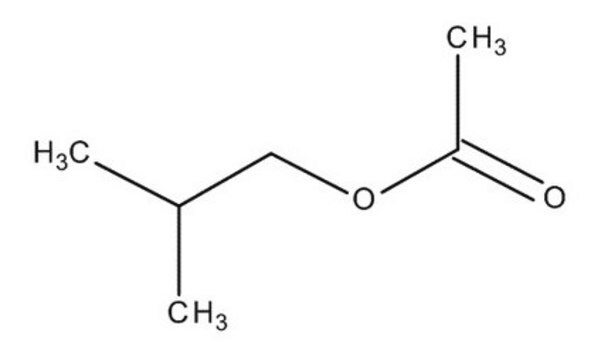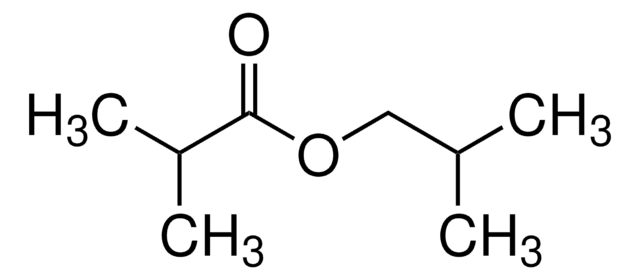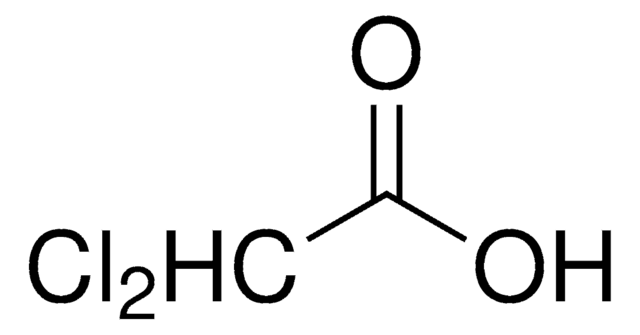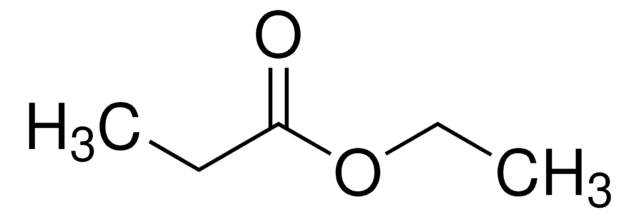Kluczowe dokumenty
537470
Isobutyl acetate
99%
Synonim(y):
Acetic acid isobutyl ester
About This Item
Polecane produkty
gęstość pary
>4 (vs air)
Poziom jakości
ciśnienie pary
15 mmHg ( 20 °C)
Próba
99%
Formularz
liquid
temp. samozapłonu
793 °F
granice wybuchowości
10.5 %
zanieczyszczenia
≤0.050% (water)
współczynnik refrakcji
n20/D 1.39 (lit.)
pH
6.7 (20 °C, 5 g/L)
bp
115-117 °C (lit.)
mp
−99 °C (lit.)
rozpuszczalność
water: soluble 5.6 g/L at 20 °C
gęstość
0.867 g/mL at 25 °C (lit.)
ciąg SMILES
CC(C)COC(C)=O
InChI
1S/C6H12O2/c1-5(2)4-8-6(3)7/h5H,4H2,1-3H3
Klucz InChI
GJRQTCIYDGXPES-UHFFFAOYSA-N
Szukasz podobnych produktów? Odwiedź Przewodnik dotyczący porównywania produktów
Powiązane kategorie
Opis ogólny
Zastosowanie
- Zielona synteza estrów smakowych przy użyciu esterazy morskiej Candida parapsilosis ekspresjonowanej w Saccharomyces cerevisiae...: Niniejsze badanie demonstruje podejście zielonej syntezy z wykorzystaniem esterazy morskiej do produkcji estrów smakowych, w tym octanu izobutylu. Proces wykorzystuje Saccharomyces cerevisiae, pokazując potencjał zrównoważonej produkcji środków aromatyzujących w przemyśle spożywczym i napojów (Xue et al., 2020).
- Monitorowanie reakcji syntezy entakaponu na linii produkcyjnej za pomocą spektroskopii Ramana i analizy wielowymiarowej...: Badania te wykorzystują spektroskopię Ramana do monitorowania syntezy entakaponu w czasie rzeczywistym. Octan izobutylu jest wykorzystywany jako rozpuszczalnik w reakcji, podkreślając jego znaczenie w syntezie farmaceutycznej i monitorowaniu procesu (Novak et al., 2011).
- Ekspozycja na rozcieńczalnik do farbhamuje syntezę i wydzielanie testosteronu w sposób odwracalny u szczurów: W niniejszym badaniu zbadano wpływ ekspozycji na rozcieńczalnik do farb, który zawiera octan izobutylu, na syntezę testosteronu u szczurów. Wyniki badania zapewniają wgląd w potencjalne właściwości zaburzające gospodarkę hormonalną octanu izobutylu w zastosowaniach przemysłowych (Yilmaz et al., 2006).
- Przygotowanie sferycznie aglomerowanych kryształów aminofiliny...: Badania te dotyczą przygotowania kryształów aminofiliny przy użyciu octanu izobutylu jako rozpuszczalnika. Badanie podkreśla użyteczność związku w preparatach farmaceutycznych w celu zwiększenia rozpuszczalności i biodostępności leku (Kawashima et al., 1984).
Hasło ostrzegawcze
Danger
Zwroty wskazujące rodzaj zagrożenia
Zwroty wskazujące środki ostrożności
Klasyfikacja zagrożeń
Flam. Liq. 2 - STOT SE 3
Organy docelowe
Central nervous system
Kod klasy składowania
3 - Flammable liquids
Klasa zagrożenia wodnego (WGK)
WGK 1
Temperatura zapłonu (°F)
71.6 °F - Pensky-Martens closed cup
Temperatura zapłonu (°C)
22 °C - Pensky-Martens closed cup
Wybierz jedną z najnowszych wersji:
Masz już ten produkt?
Dokumenty związane z niedawno zakupionymi produktami zostały zamieszczone w Bibliotece dokumentów.
Klienci oglądali również te produkty
Produkty
Butyl methyl ether; Acetic acid; 2-Butanone; Ethyl acetate; Tetrahydrofuran; 1-Butanol; Isopropyl acetate; Heptane; Propyl acetate; 3-Methylbutanol; 4-Methyl-2-pentanone; Isobutyl acetate; Butyl acetate; Dimethyl sulfoxide; Anisole; Cumene
Protokoły
Separation of Acetone; Acetic acid; Propionic acid; Ethyl butyrate; Ethanol; Isoamyl acetate; Isobutyric acid; 3-Methyl-2-butanol; Methyl acetate; 1-Propanol; Acetal, ≥98%, FG; 2-Methyl-1-pentanol; Butyl acetate; Ethyl propionate; 3-Pentanol; 2-Pentanol, 98%; Ethyl isobutyrate; Isobutyl acetate; Acetaldehyde; Furfural; Butyric acid; Methanol; Ethyl acetate
GC Analysis of Class 3 Residual Solvents on SUPELCOWAX® 10
Nasz zespół naukowców ma doświadczenie we wszystkich obszarach badań, w tym w naukach przyrodniczych, materiałoznawstwie, syntezie chemicznej, chromatografii, analityce i wielu innych dziedzinach.
Skontaktuj się z zespołem ds. pomocy technicznej













